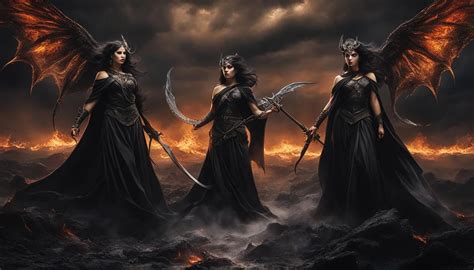The Greek Furies myth, also known as the Erinyes, is a complex and fascinating aspect of ancient Greek mythology. The Furies were a group of goddesses who embodied the spirit of vengeance and punishment, and their story is deeply intertwined with the broader mythological landscape of ancient Greece. To understand the significance of the Furies, it is essential to delve into their origins, roles, and the various myths that feature them.
Origins and Roles of the Furies

According to Greek mythology, the Furies were born from the blood of the primordial god Uranus, who was castrated by his son Cronus. This violent act led to the creation of the Furies, who were tasked with avenging crimes against the natural order, particularly those related to family and social hierarchy. The Furies were often depicted as three sisters: Alecto, Tisiphone, and Megaera, each with distinct characteristics and roles. Alecto was associated with unending anger, Tisiphone with vengeance, and Megaera with jealousy.
Mythological Significance of the Furies
The Furies played a crucial role in maintaining social order and ensuring that individuals who committed crimes against the natural order were punished. They were feared and respected in equal measure, as their wrath was considered unstoppable. The Furies were also associated with the concept of guilt and shame, as they would torment the consciences of those who had committed wrongdoing. This aspect of their role highlights the psychological complexity of ancient Greek mythology, where the internal struggle with guilt and the fear of divine retribution were powerful motivators for human behavior.
| Characteristics of the Furies | Description |
|---|---|
| Alecto | Associated with unending anger |
| Tisiphone | Associated with vengeance |
| Megaera | Associated with jealousy |

Key Myths Featuring the Furies

The Furies appear in several significant myths, including the story of Orestes, who killed his mother Clytemnestra to avenge his father’s death. The Furies pursued Orestes, seeking to punish him for his matricide, but he was eventually acquitted by the gods. This myth highlights the complexities of justice and morality in ancient Greek society, where the Furies represented the unyielding demand for vengeance. Another notable myth featuring the Furies is the story of the Danaids, who were punished by the Furies for killing their husbands on their wedding night.
Symbolism and Cultural Significance
The Furies have been interpreted in various ways throughout history, with some viewing them as symbols of the unconscious mind or the embodiment of feminine rage. Their association with snakes, darkness, and the underworld reinforces their connection to the mysterious and often feared aspects of human nature. The Furies’ role in maintaining social order also reflects the cultural values of ancient Greece, where family and social hierarchy were paramount.
Key Points
- The Furies were a group of goddesses who embodied the spirit of vengeance and punishment in ancient Greek mythology.
- They were born from the blood of Uranus and tasked with avenging crimes against the natural order.
- The Furies were associated with guilt, shame, and the psychological torment of those who committed wrongdoing.
- They played a crucial role in maintaining social order and ensuring that individuals who committed crimes were punished.
- The Furies appear in several significant myths, including the stories of Orestes and the Danaids.
The Greek Furies myth continues to fascinate and intrigue, offering insights into the complexities of human nature, morality, and the enduring power of guilt and shame. As a testament to the richness and depth of ancient Greek mythology, the story of the Furies remains an essential part of our cultural heritage, inviting us to reflect on the consequences of our actions and the importance of maintaining social order.
What was the primary role of the Furies in ancient Greek mythology?
+The primary role of the Furies was to avenge crimes against the natural order, particularly those related to family and social hierarchy.
How did the Furies embody the concept of guilt and shame?
+The Furies embodied the concept of guilt and shame by tormenting the consciences of those who had committed wrongdoing, serving as a reminder of the psychological complexity of ancient Greek mythology.
What is the cultural significance of the Furies in ancient Greek society?
+The Furies represented the unyielding demand for vengeance and the importance of maintaining social order, reflecting the cultural values of ancient Greece, where family and social hierarchy were paramount.



